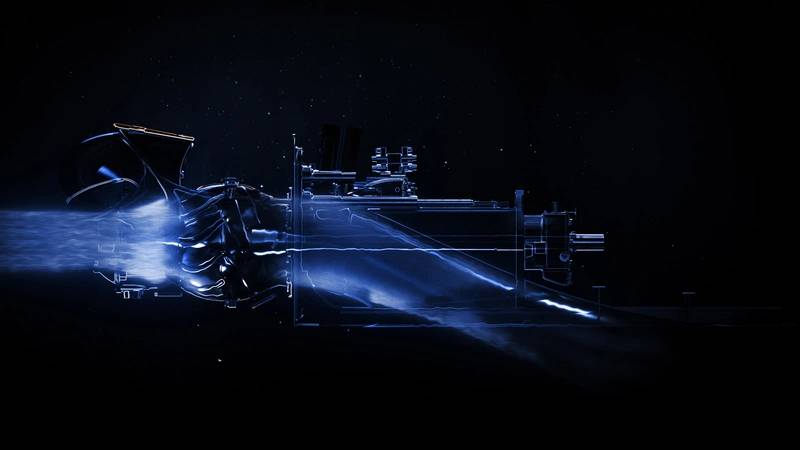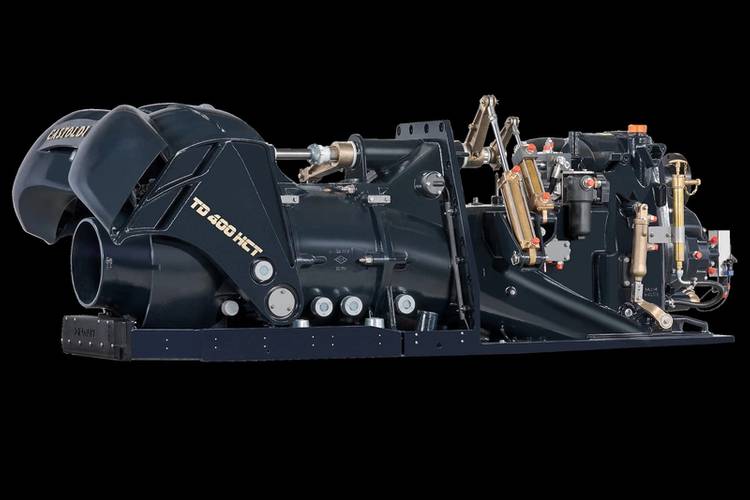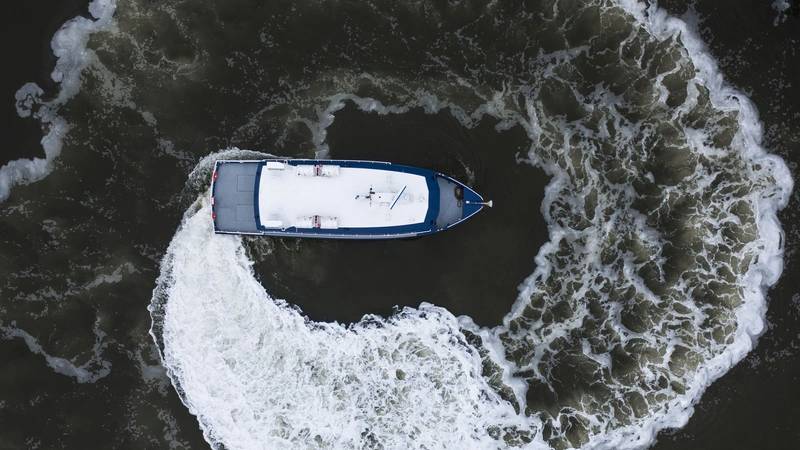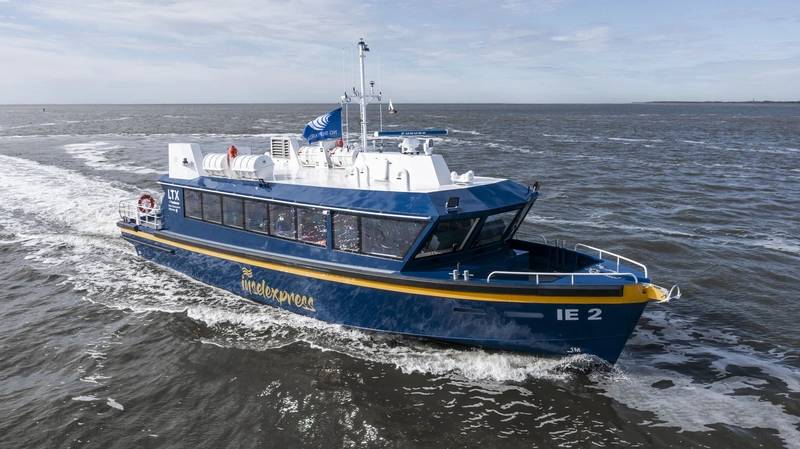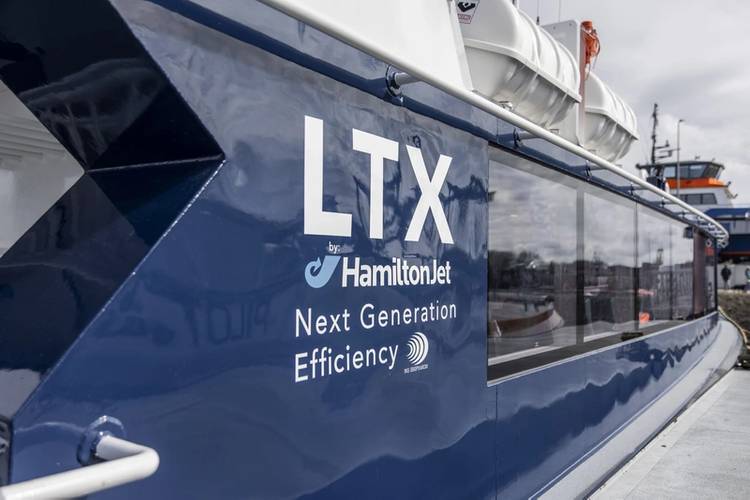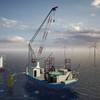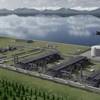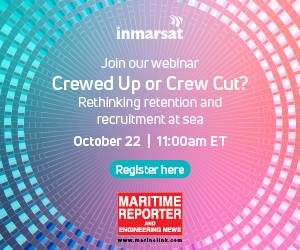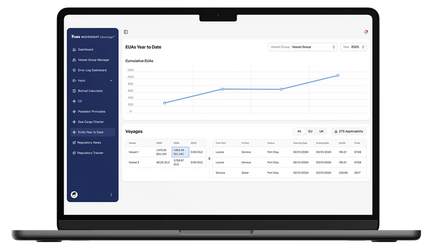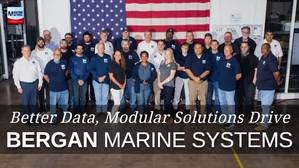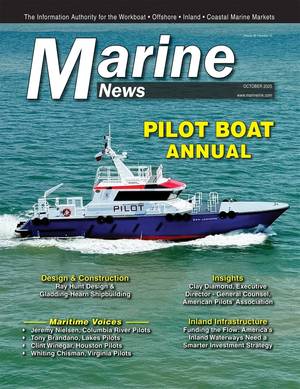Maritime Propulsion: Expanding Options for Waterjets
It’s no surprise that waterjets are great for shallow-draft, highly maneuverable craft, but vessel designers are busting out of the old stereotypes.
Vessel designer Aircat Vessels has developed a surface effect ship (SES) crew transport catamaran, AIRCAT 35 Crewliner, that can sail at over 50 knots and manage offshore transfers in 2.5-meter seas. The air cushion system from ESNA dynamically adjusts to sea conditions so the vessel can reduce transit times, reduce fuel consumption and improve comfort for passengers travelling at high speed.
The first three vessels are now being operated by All Energies Services (AES) in Angola, taking passengers out to TotalEnergies Angola’s offshore sites.
The Aircat vessel design was also recently taken up Centus Marine, and Strategic Marine is building the vessel which includes four of Kongsberg Maritime’s Kamewa waterjets. Th waterjet’s inlet nozzles are always covered by water even though the submerged volume of the vessel reduces by up to 80% when the air cushion is in use.
“In high-risk maritime environments, the ability to stop fast and reliably can be the difference between routine operation and disaster,” says Anders Valkeinen, Vice-President Sales, High-Speed Craft at Kongsberg Maritime. “Kamewa Waterjets’ unique ability to generate full reverse thrust enables vessels to come to a complete stop in just 1.5 boat lengths at speeds of 30 knots. This can be game-changing for operators like Aircat, whose high-efficiency crew transfer vessels operate near offshore platforms. When the unexpected happens, this capability becomes a critical safety tool.”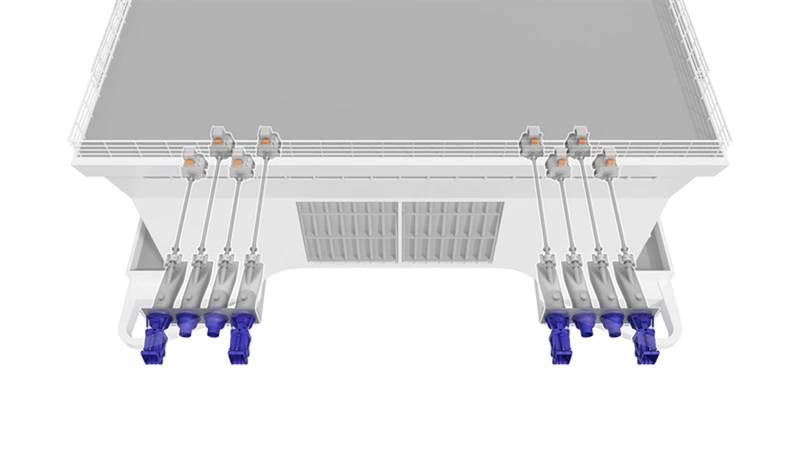 A new ferry being built by Incat Tasmania for Buquebús will be powered by a battery electric propulsion system and eight waterjets from Wärtsilä.
A new ferry being built by Incat Tasmania for Buquebús will be powered by a battery electric propulsion system and eight waterjets from Wärtsilä.
Images Courtesy Wärtsilä
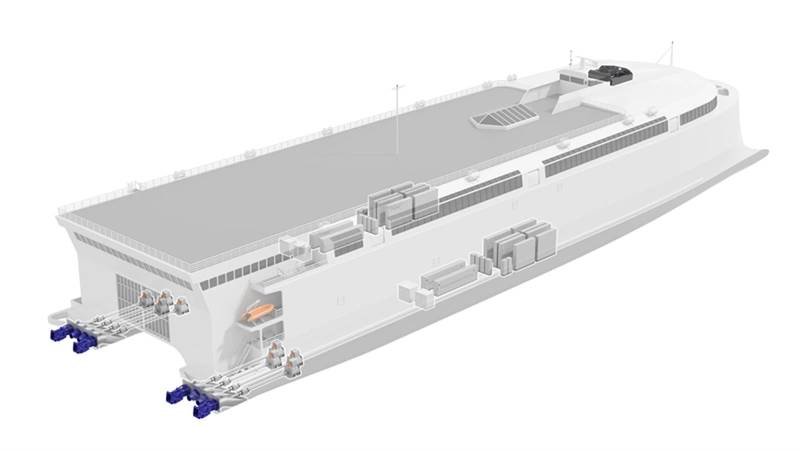
The Aircat vessels are a first for SES for Strategic Marine. They may be the start of an increasing trend, but there is another trend that is already taking hold – a push for pairing waterjets with electric propulsion.
In January, two hybrid ferries were christened for Chatham Area Transit of Savannah, Georgia. Built by Derecktor Shipyards New York, they are powered by two waterjets from Marine Jet Power (MJP). These 65-foot vessels represent a significant milestone as the first hybrid passenger ferries in the United States powered by waterjet propulsion.
Another record is being set by a new ferry being built by Incat Tasmania in Australia for Buquebús in Uruguay. The vessel will be the world’s largest zero-emissions, lightweight catamaran ferry, and it will be powered by a battery electric propulsion system and eight waterjets from Wärtsilä. At 426 feet, it will be the biggest battery electric ship ever built.
The propulsion package includes eight permanent magnet e-motors, four steerable waterjets plus four booster (non-steerable) jets. The compact and lightweight axial flow WXJ1100 waterjets are optimized for medium speed (25 knots). The WXJ waterjet has a relatively small flange, so the jets can be placed close to one another on the transom, says Leendert Muilwijk, General Manager, Waterjets, Wärtsilä Marine. As the power is divided over more jets, the power density of each is lower, which means higher efficiency.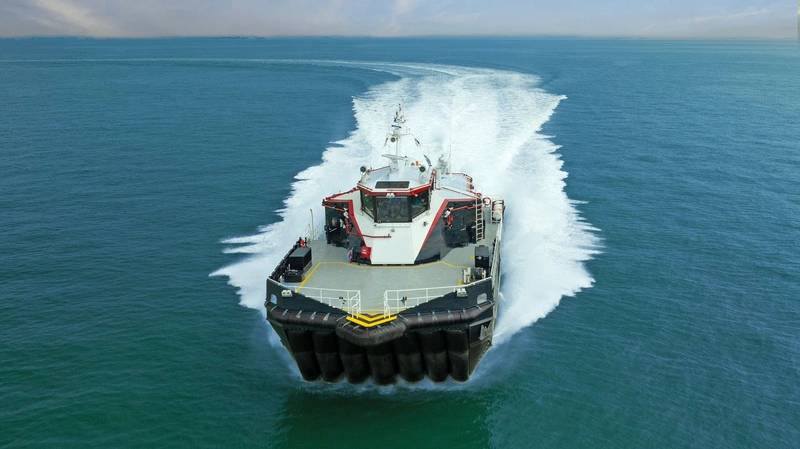 Aircat Vessels has developed a surface effect ship (SES) crew transport catamaran, AIRCAT 35 Crewliner, that features an air cushion system from ESNA. Image Courtesy ESNA
Aircat Vessels has developed a surface effect ship (SES) crew transport catamaran, AIRCAT 35 Crewliner, that features an air cushion system from ESNA. Image Courtesy ESNA
The AIRCAT 35 Crewliner is an air-cushioned catamaran, high speed crew transport vessel.
The total number of jets does not adversely affect maneuverability, says Muilwijk, as the jets can be grouped to create one resultant thrust vector on each side of the hull. This allows for a similar or better maneuvering thrust compared to a more conventional configuration with fewer larger waterjets. It also comes with a weight advantage and increases propulsion redundancy.
Electric motors have a different power curve and RPM range to combustion engines, and this necessitates adjustments to a waterjet’s impeller shape and size to ensure maximum efficiency. Martyn Bowden, Head of Propulsion at NAMJet, says: “With electrification, you need a higher efficiency at lower speed, which means a larger diameter impeller and preferably lower impeller speed. Much of the power in a high-speed craft is used reaching planing speed at around 15-20 knots. A boat is least efficient from zero to planing speed. Our jets are different to other manufacturers catering to the electric market. Due to the Mass Flow pump design we run at a much lower RPM, because the bigger the impeller, the better low speed efficiency.”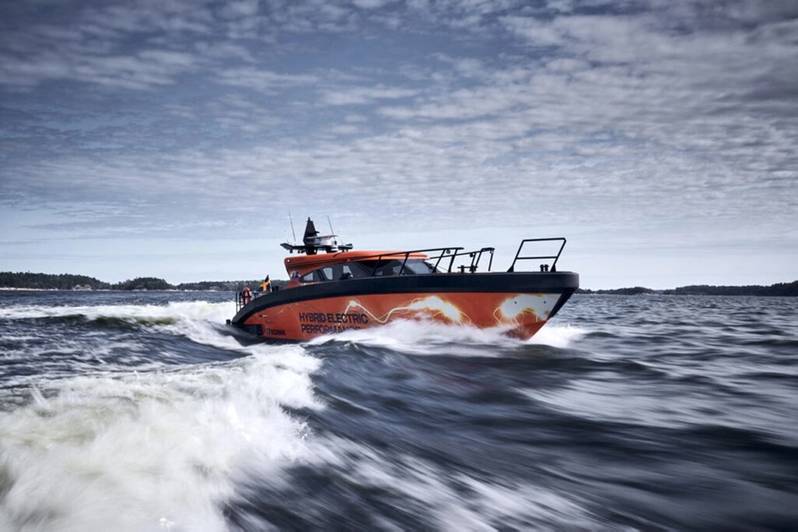 Two hybrid ferries were built by Derecktor Shipyards New York and powered by two waterjets from MFP for Chatham Area Transit of Savannah, Georgia.
Two hybrid ferries were built by Derecktor Shipyards New York and powered by two waterjets from MFP for Chatham Area Transit of Savannah, Georgia.
Image Courtesy MJP
NAMJet focuses on the milpro market, and Bowden cites a recent delivery that demonstrates a new approach to the retrofit market. The company enabled the Swedish Armed Forces to repower all 60 of their old tug boats as part of a maintenance budget rather than as new acquisitions. “We designed a conversion kit that allowed them to use the same waterjet as their new boats with about 90% of the same parts without having to replace any structural components. Performance was increased by 50% on what were previous NAMJet waterjets installed 30 years ago. “Now, they’ve got parts compatibility for the next 30 years.”Technology developments are targeting greater power whilst also offering performance at lower speeds to boost the versatility of waterjet propulsion.
With this in mind, HamiltonJet recently launched its HTX65 waterjet. The HTX series provides high-speed efficiency while also performing well at low speeds. It features enhanced durability and easier installation due to a compact inboard footprint, narrow jet-spacing and low-profile design. With its new hydrodynamic design and harnessing 3,100kW of power, the HTX65 delivers 3.5% more high speed efficiency, enabling vessels to achieve speeds exceeding 50 knots. This is complemented by a low-loss steering system that conserves fuel during course adjustments and minimizes speed reduction during tight maneuvers.
At lower speeds, the HTX65 features a cavitation-resistant intake and pump design, providing up to 15% more peak bollard pull and greater sway thrust than other waterjets, says the company. This enhancement improves maneuvering response, position holding capability and vessel acceleration. The HTX65 has an increased impeller rating range for greater compatibility with a wider range of engines, and the fully integrated hydraulics and controls are designed for efficient space utilization and seamless integration into various platforms.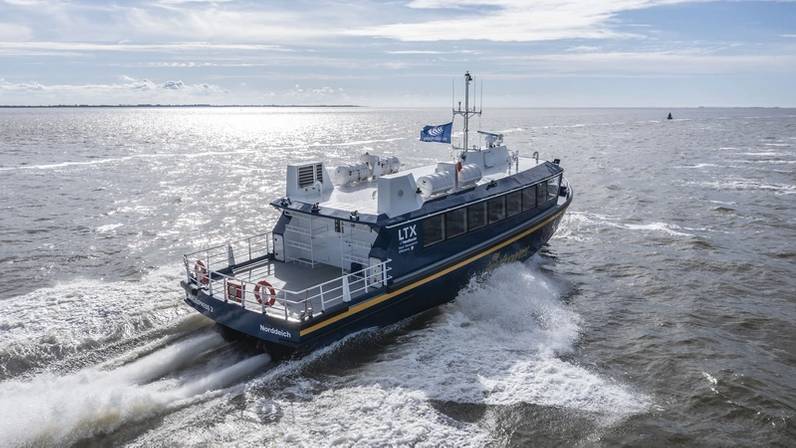 HamiltonJet’s latest innovation – the LTX waterjet – has moved from initial design to commercial reality, with the first LTX36 jets commissioned on a 20-m passenger ferry in The Netherlands. Image courtesy HamiltonJet
HamiltonJet’s latest innovation – the LTX waterjet – has moved from initial design to commercial reality, with the first LTX36 jets commissioned on a 20-m passenger ferry in The Netherlands. Image courtesy HamiltonJet
HamiltonJet’s also introduced the LTX waterjet – which has moved from initial design to commercial reality, with the first LTX36 jets commissioned on a 20-m passenger ferry in The Netherlands. “The LTX is a game changer,” says HamiltonJet Managing Director Ben Reed. “It offers propeller-like efficiency at lower speeds while maintaining all the advantages of waterjet propulsion – shallow water operation, safety, and unmatched maneuverability.”
The vessel Inselexpress 2, built by Next Generation Shipyard, is powered by twin LTX36 jets driven by Volvo D8 engines (313 bkW) via ZF gearboxes. During trials, the ferry comfortably met its predicted top speed of 23.5 knots, validating the LTX’s technical promises and its potential to reshape propulsion performance in the 20–30 knot range.
Originally launched as a new design in 2023, the LTX series is HamiltonJet’s step into the low- to medium-speed market traditionally dominated by propeller systems. The jets – now commercially available in LTX36 and LTX53 models – were inspired by nature’s most efficient swimmer: the moon jellyfish. Travelling via a low-velocity jet of water, the jellyfish achieves exceptional efficiency through a large nozzle, minimal energy input, and a finely tuned natural design.
Castoldi also has new-generation technology. The company reports a recent delivery for a new patrol vessel for the Italian Coastguard which exceeded its design brief in an unusual early sea trial. Giacomo Castoldi, owner at Castoldi, said: “This new generation, high performance boat, christened CP335 and designed and constructed in Italy by FB Design, began its life with a demanding cruise from Venice to Puglia in winter sea conditions. The crew recorded speeds up to 38 knots, which is higher than the maximum forecast by the designers, underscoring the efficiency of the Turbodrive 400 HCT.”
Castoldi says the Turbodrive 400 HCT represents a significant milestone in the evolution of waterjet propulsion, catering to the demands of a new era that seeks ever higher performance, efficiency and control without burning more fuel to achieve it.
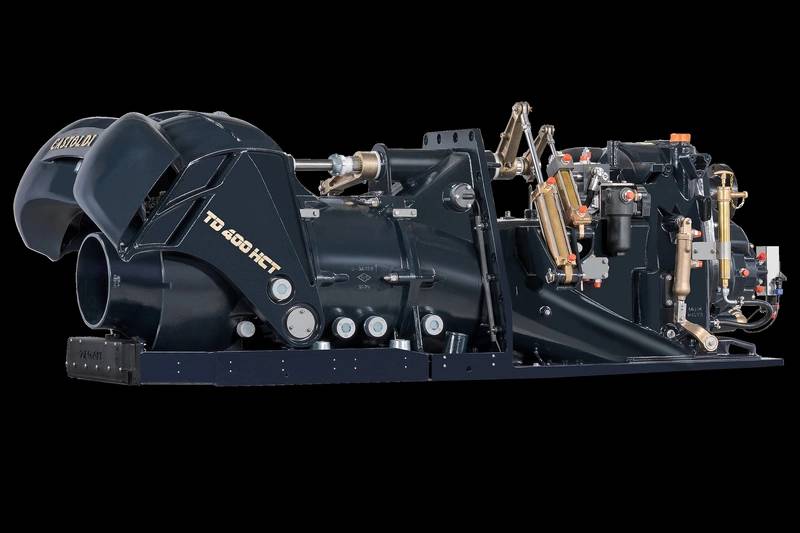 Castoldi has delivered a patrol vessel for the Italian Coastguard that exceeded its design brief.
Castoldi has delivered a patrol vessel for the Italian Coastguard that exceeded its design brief.
Image Courtesy Castoldi









